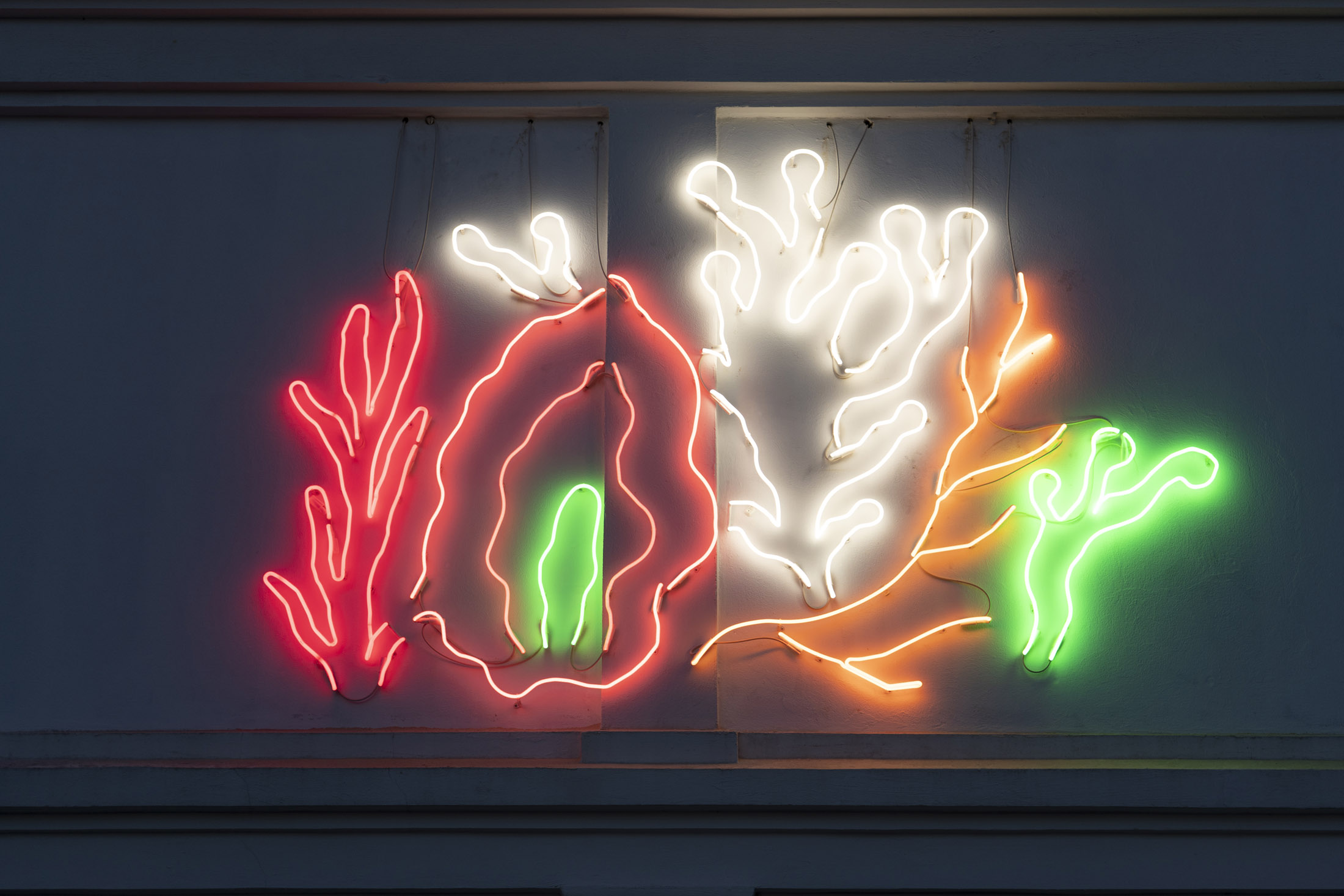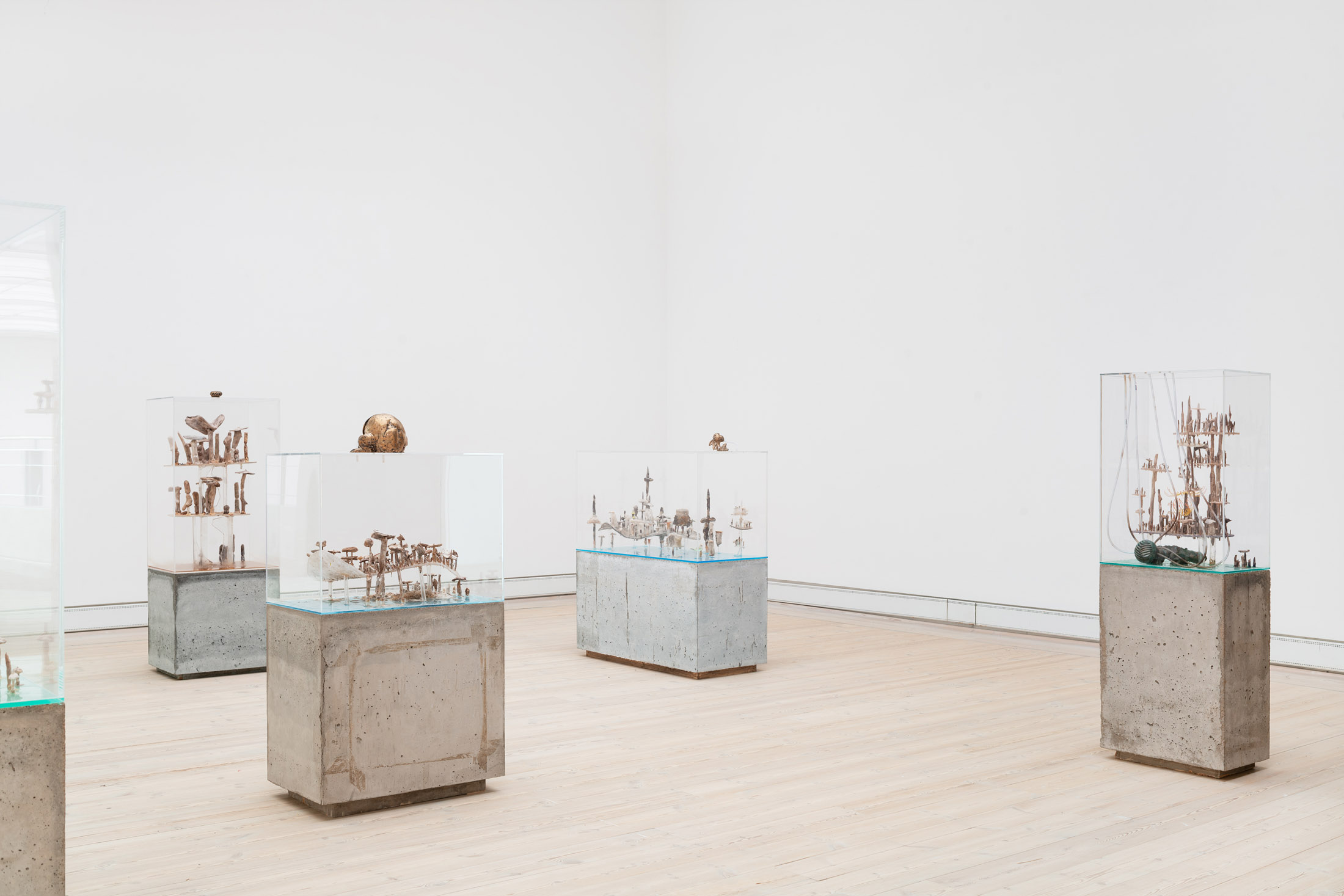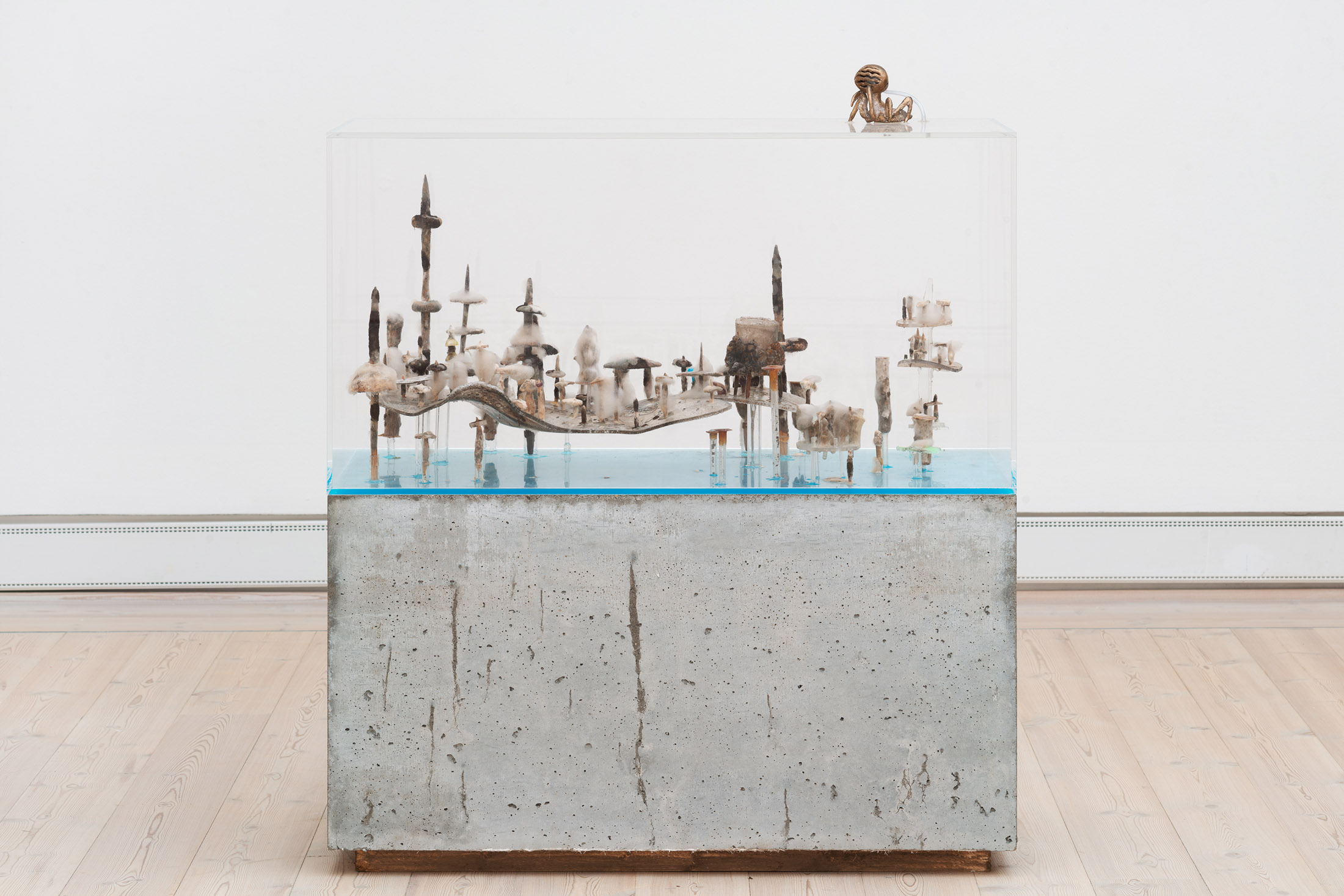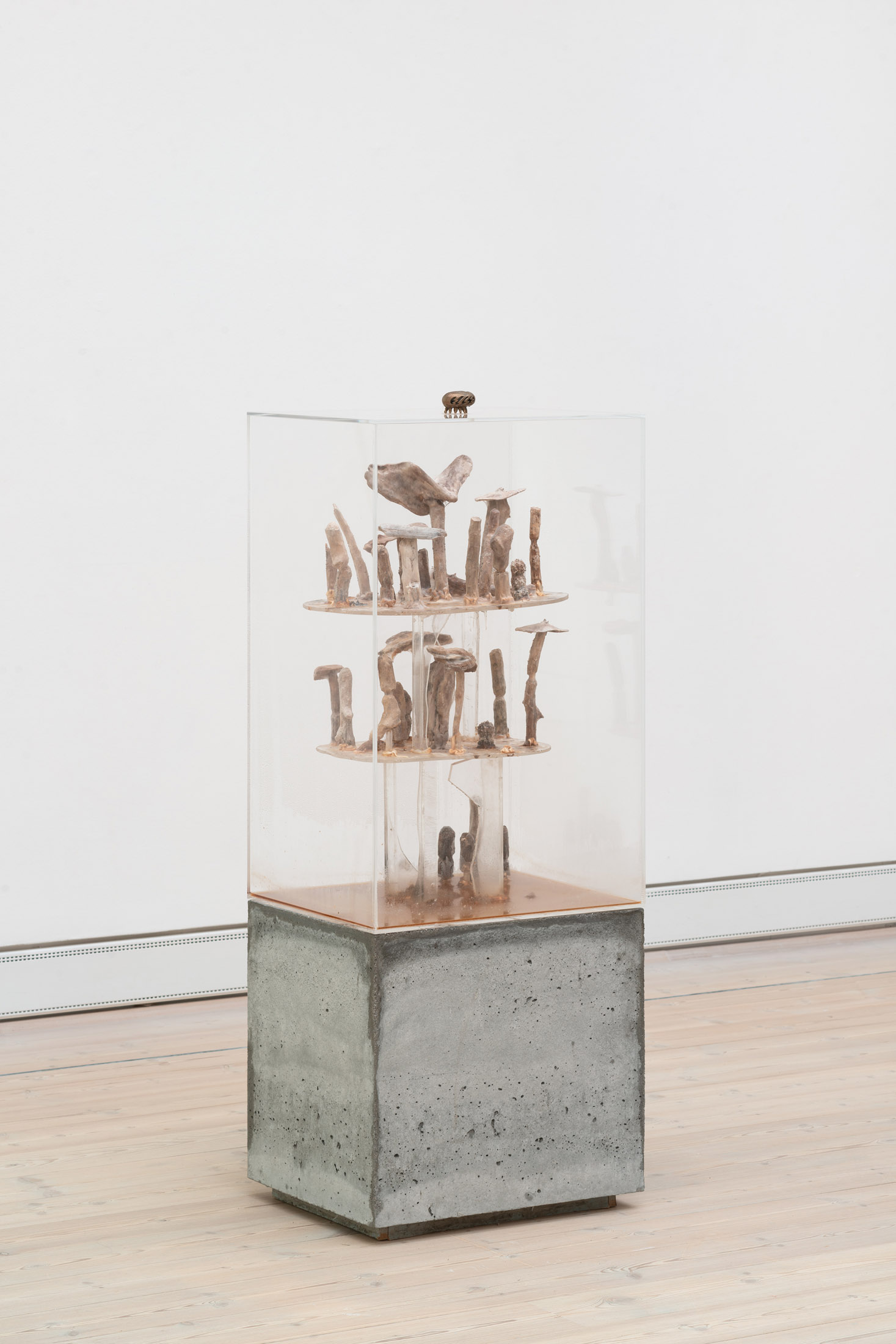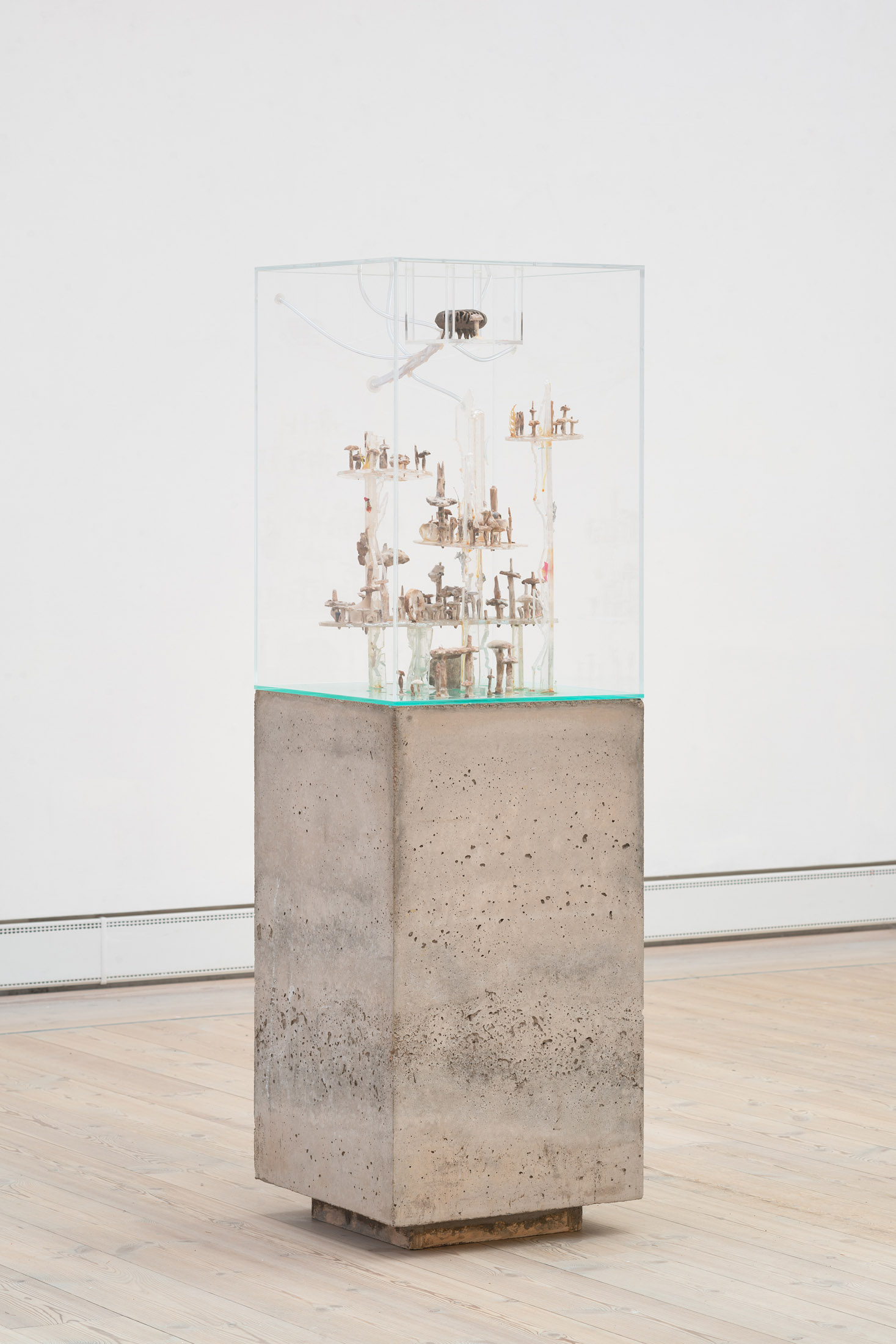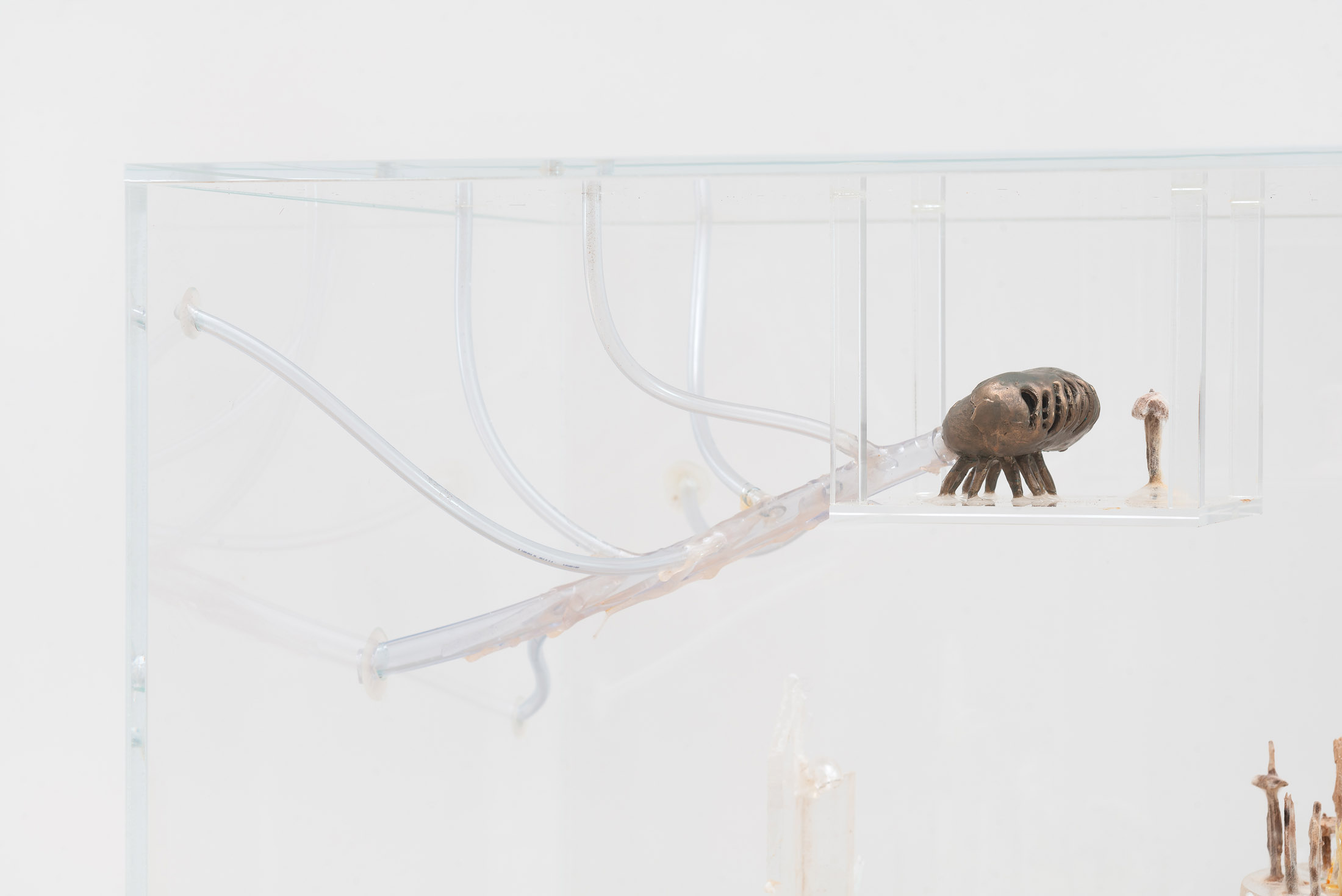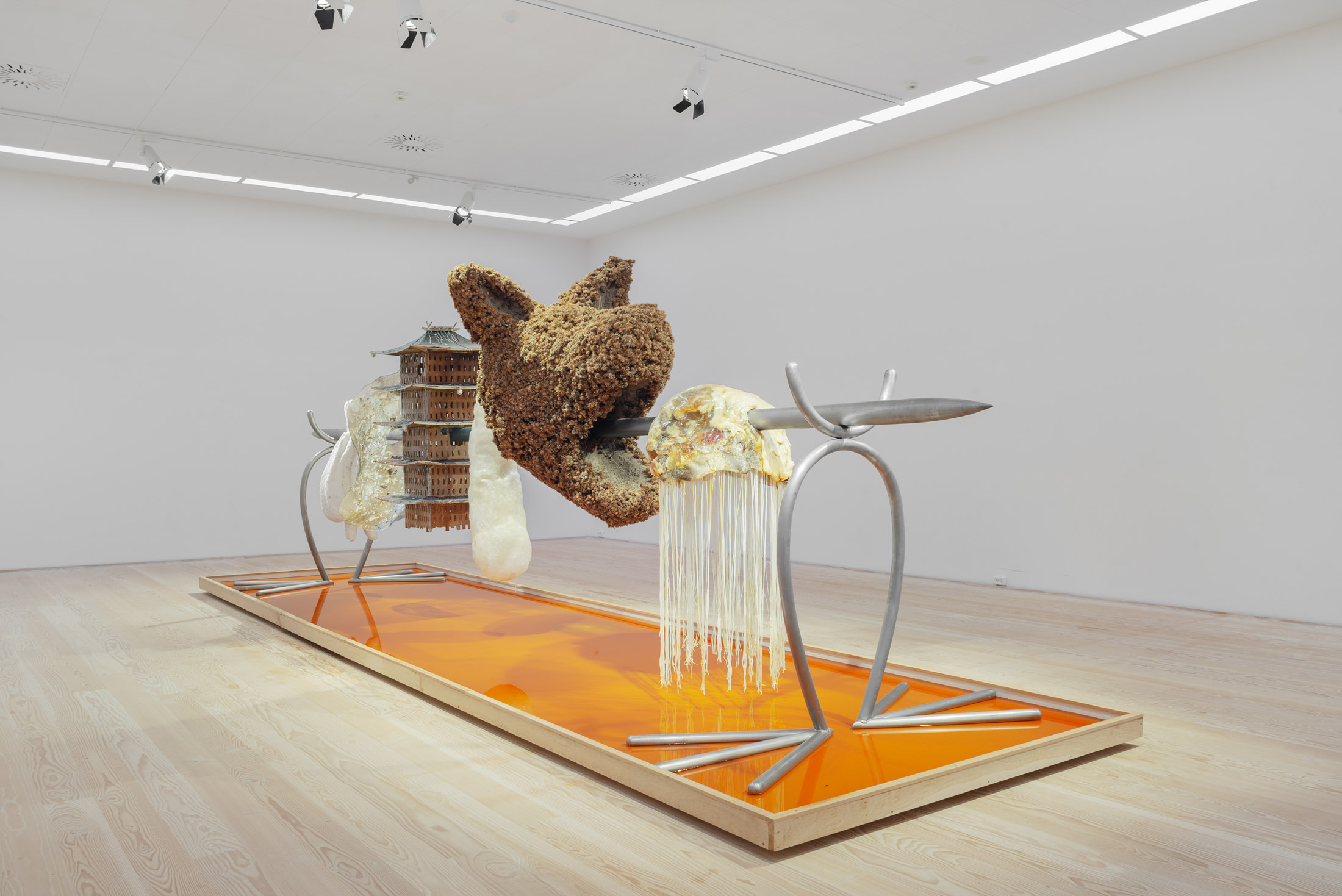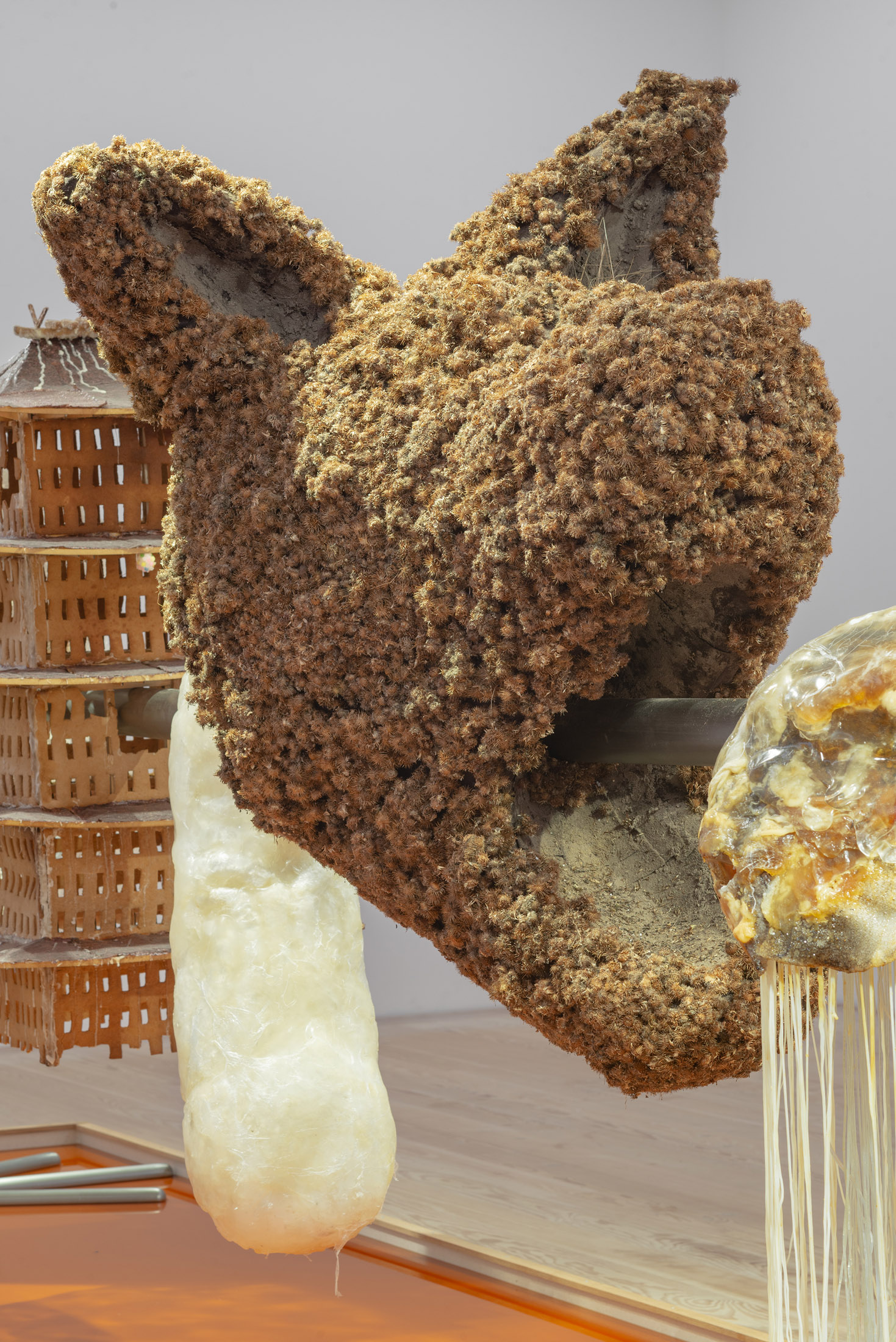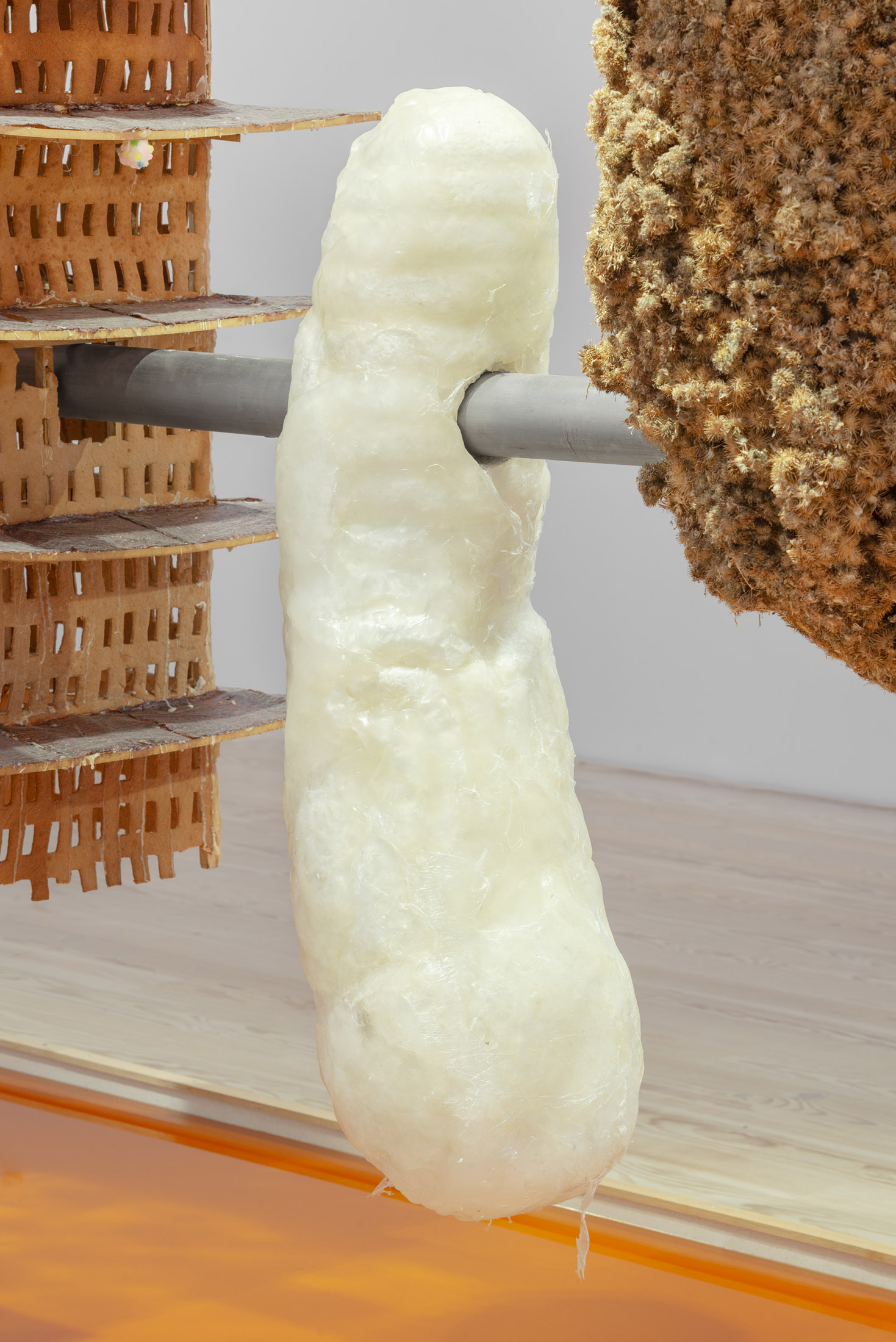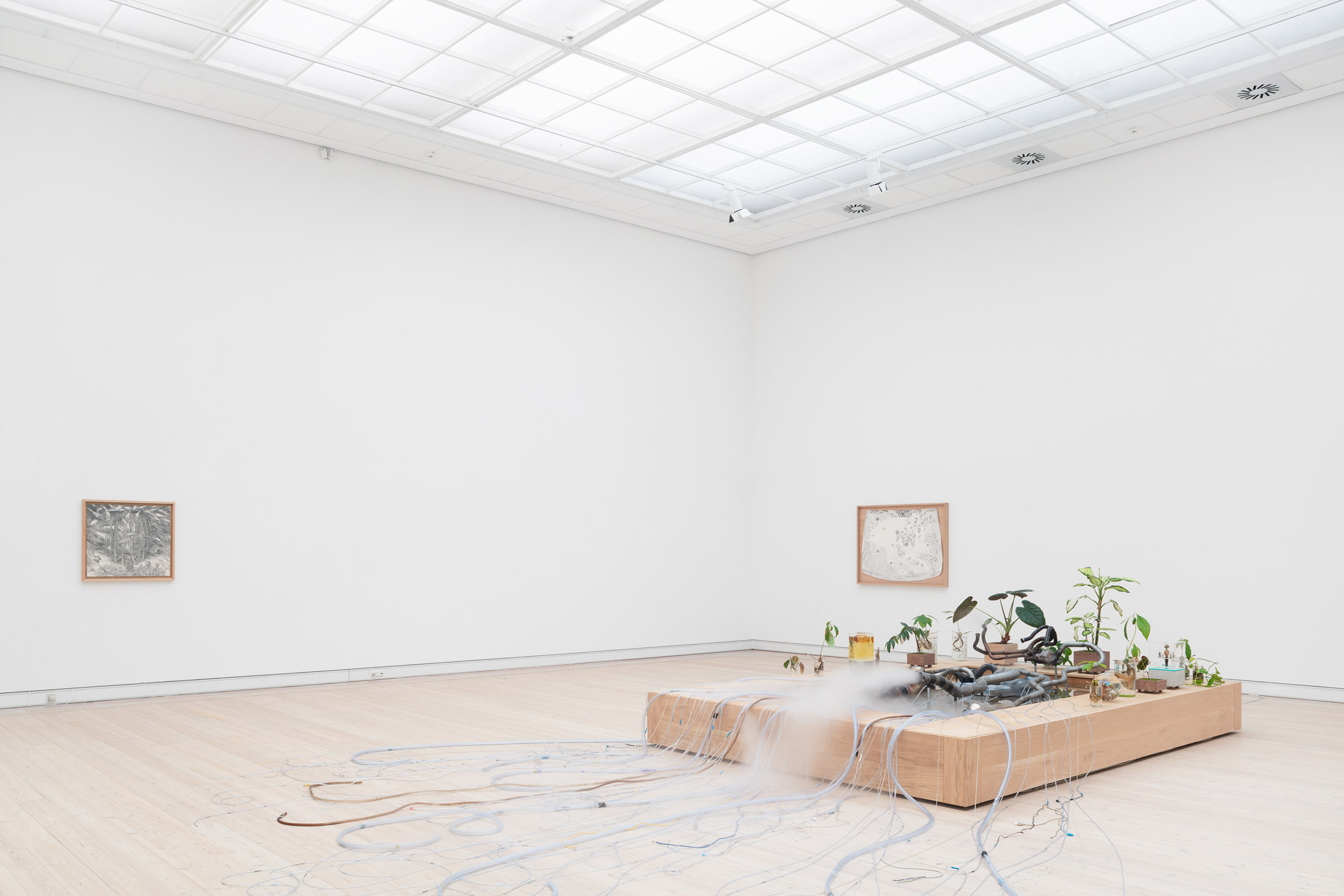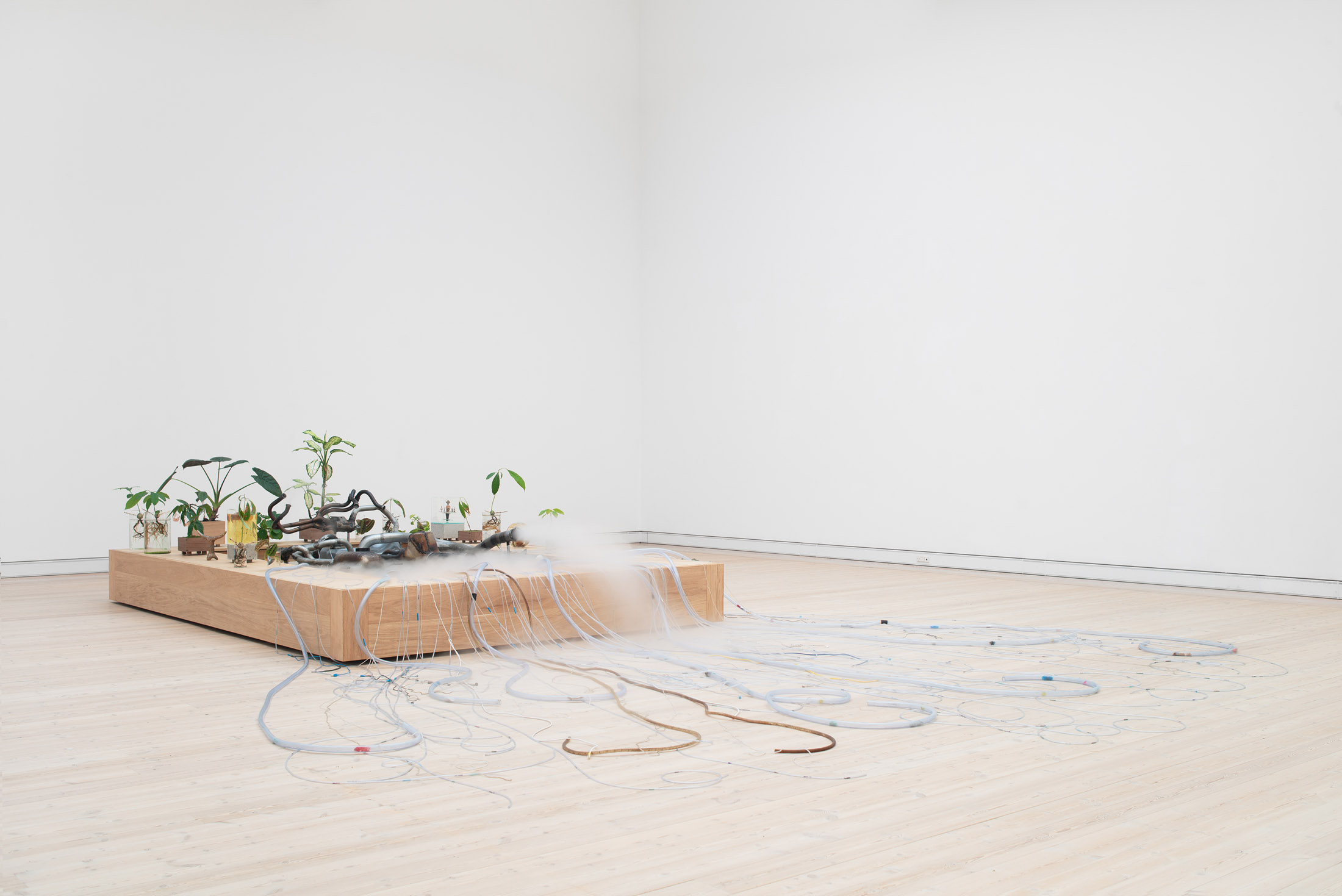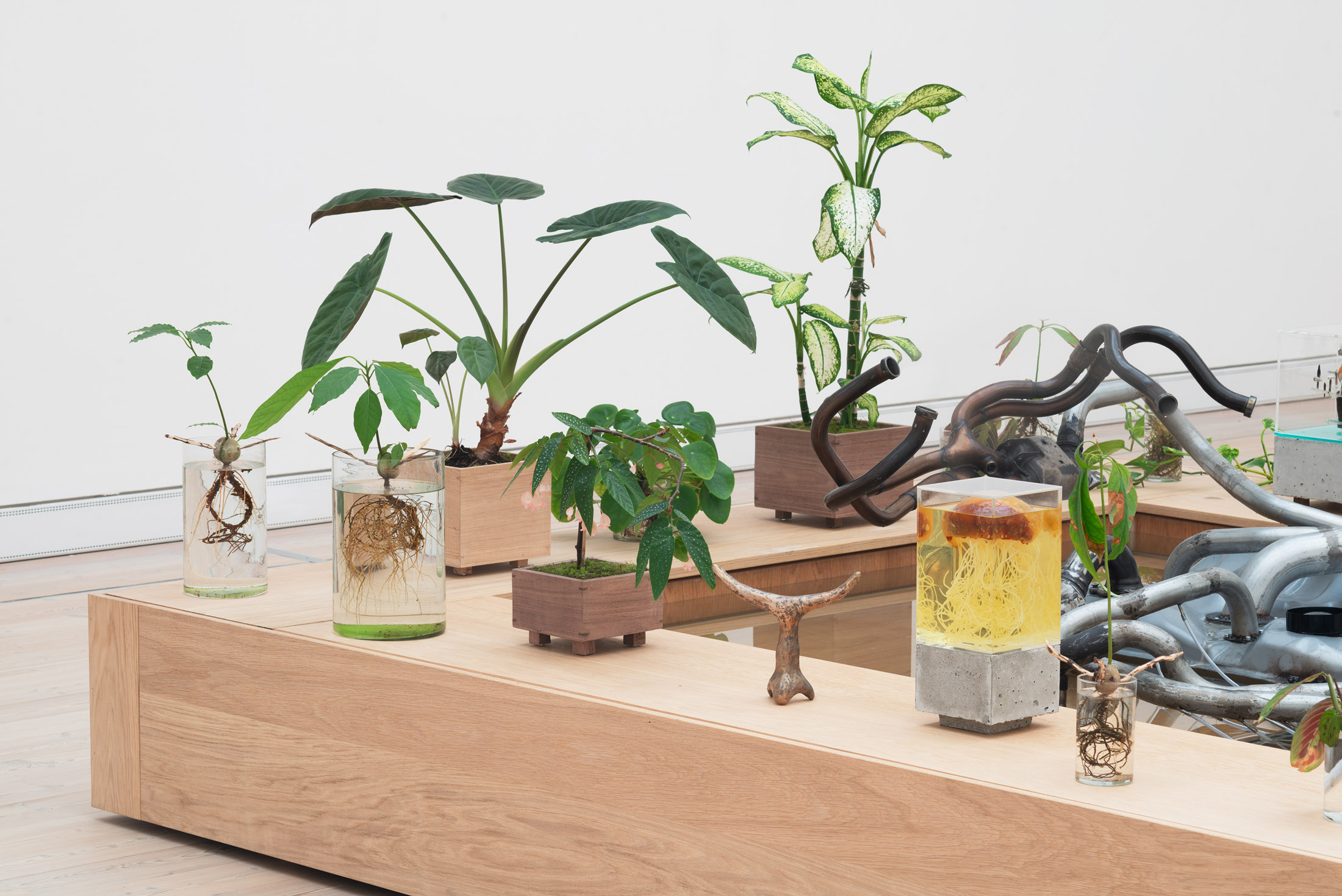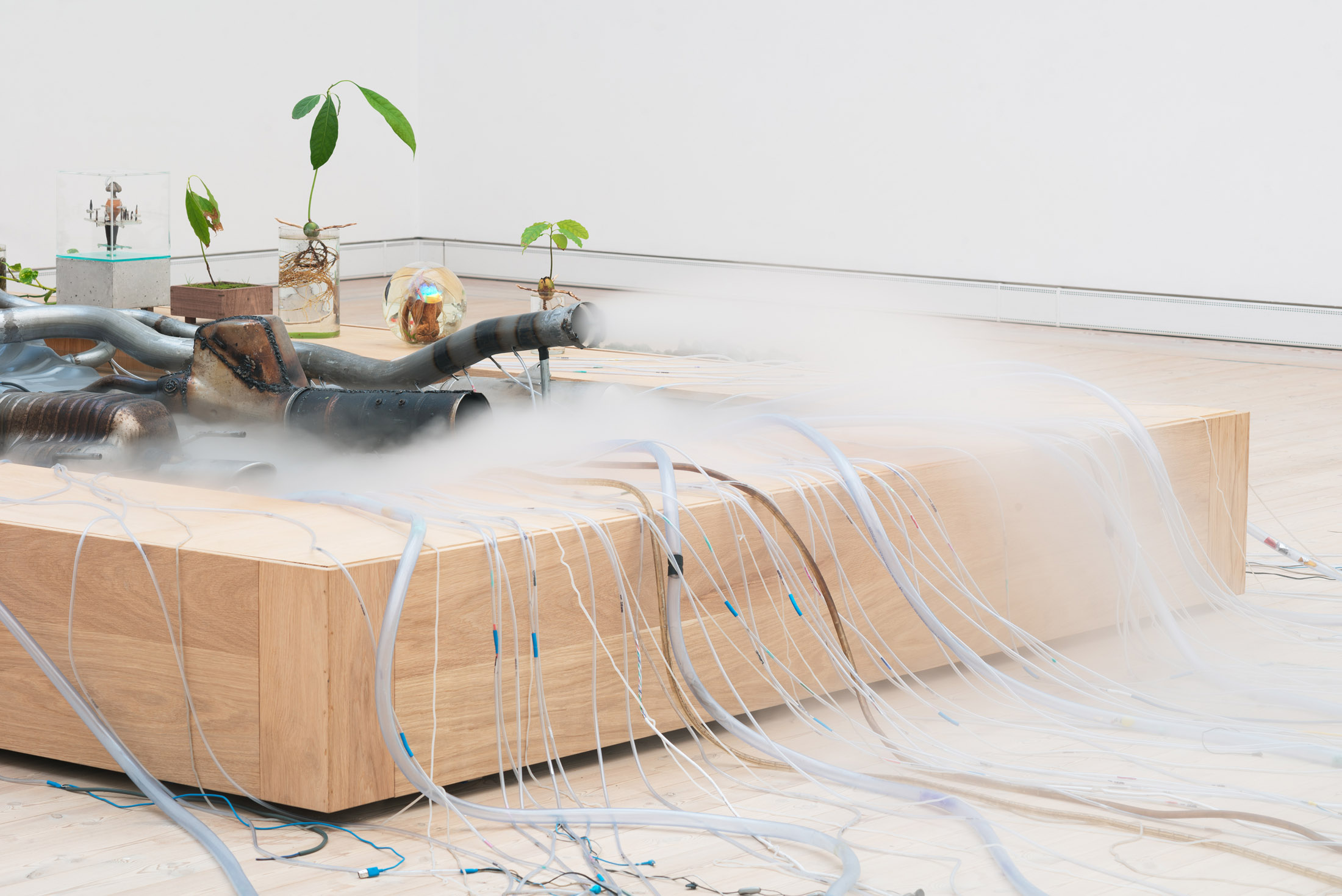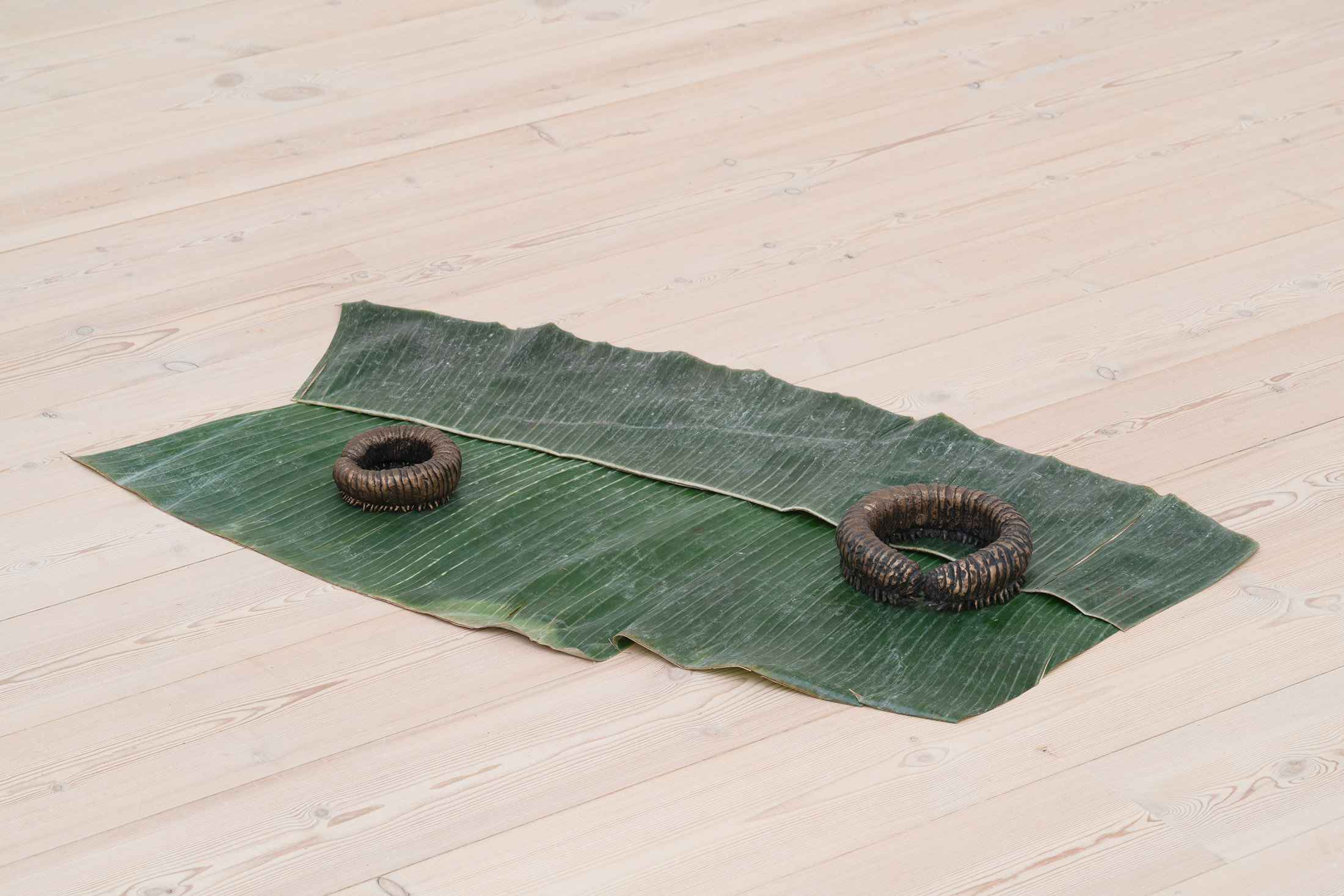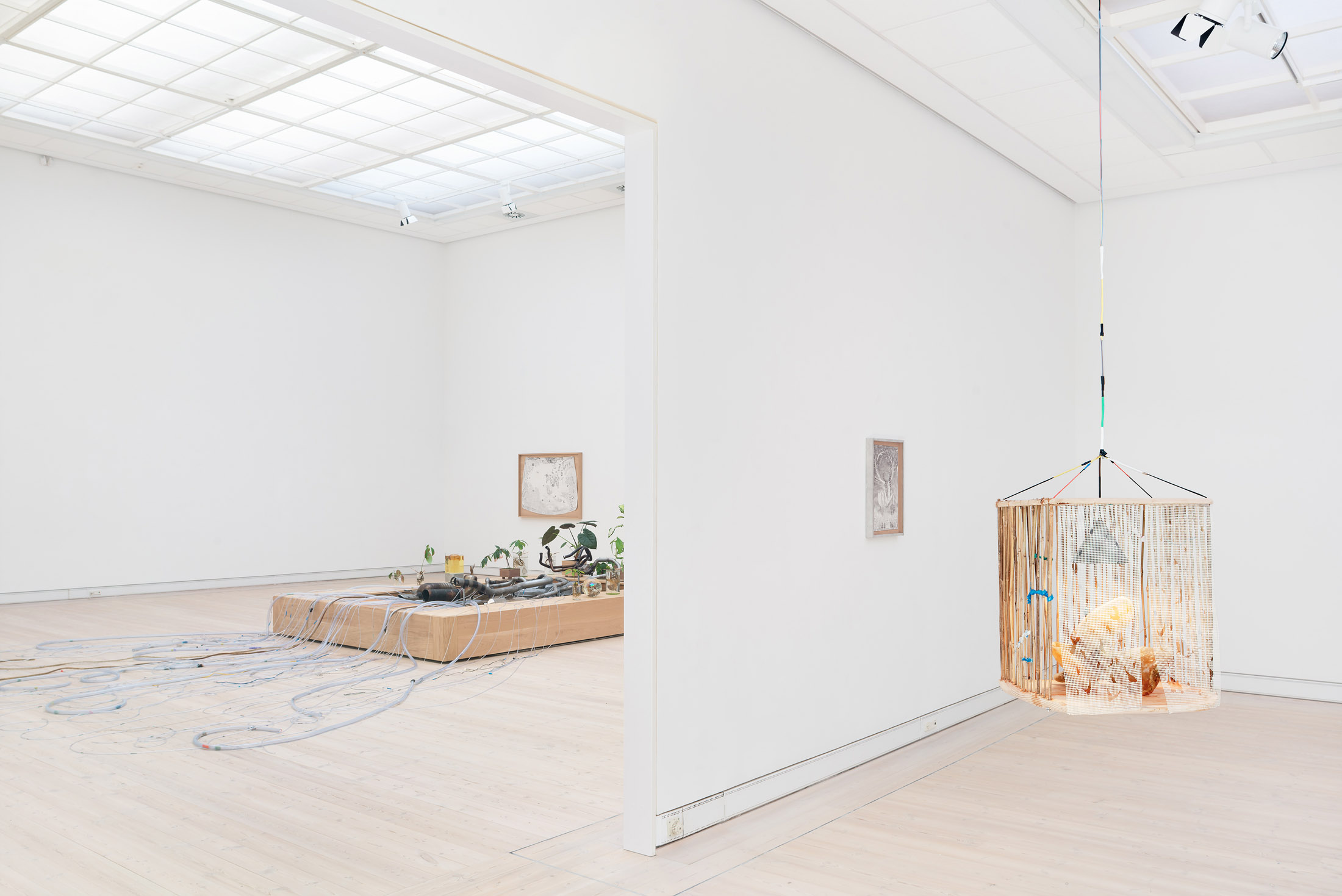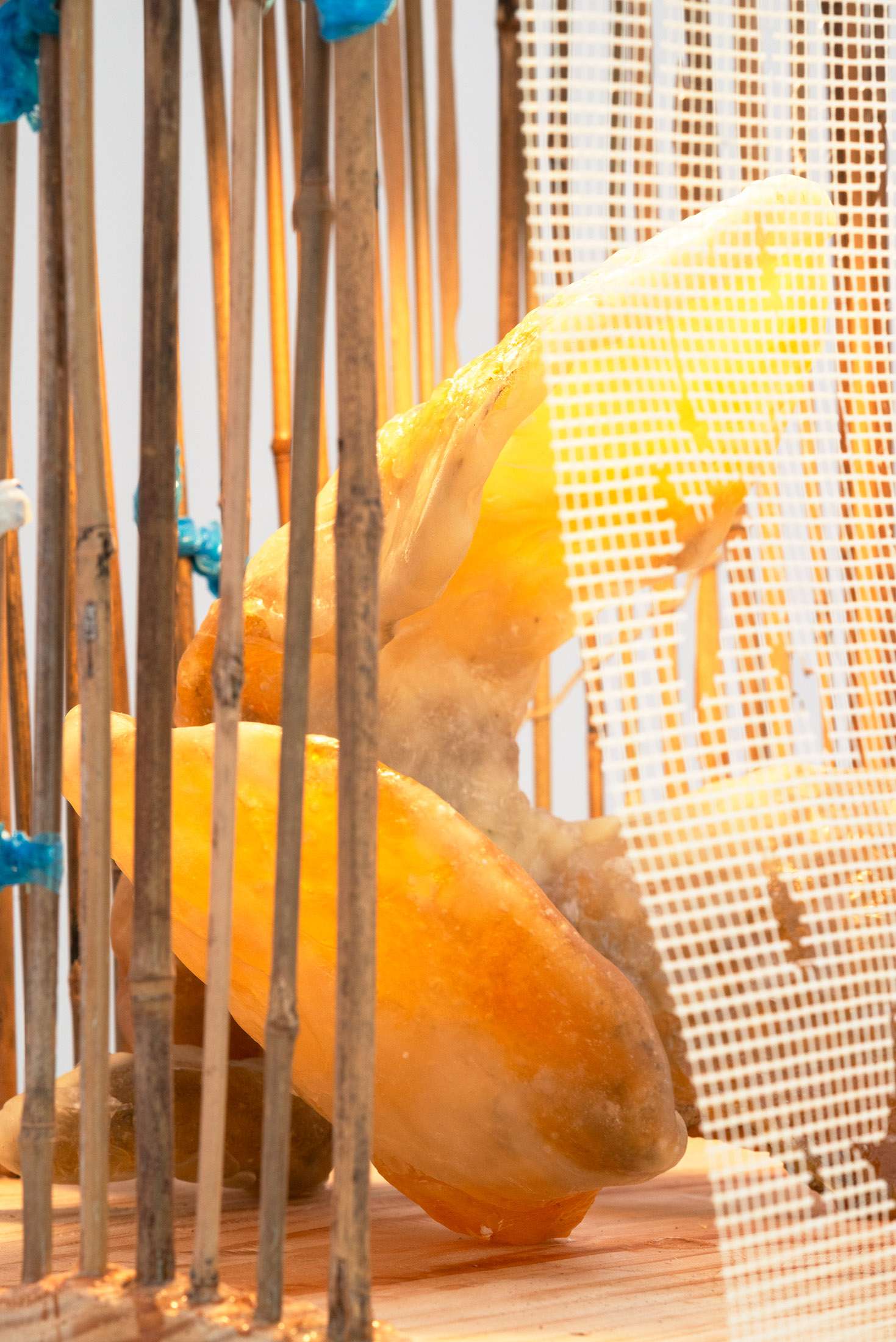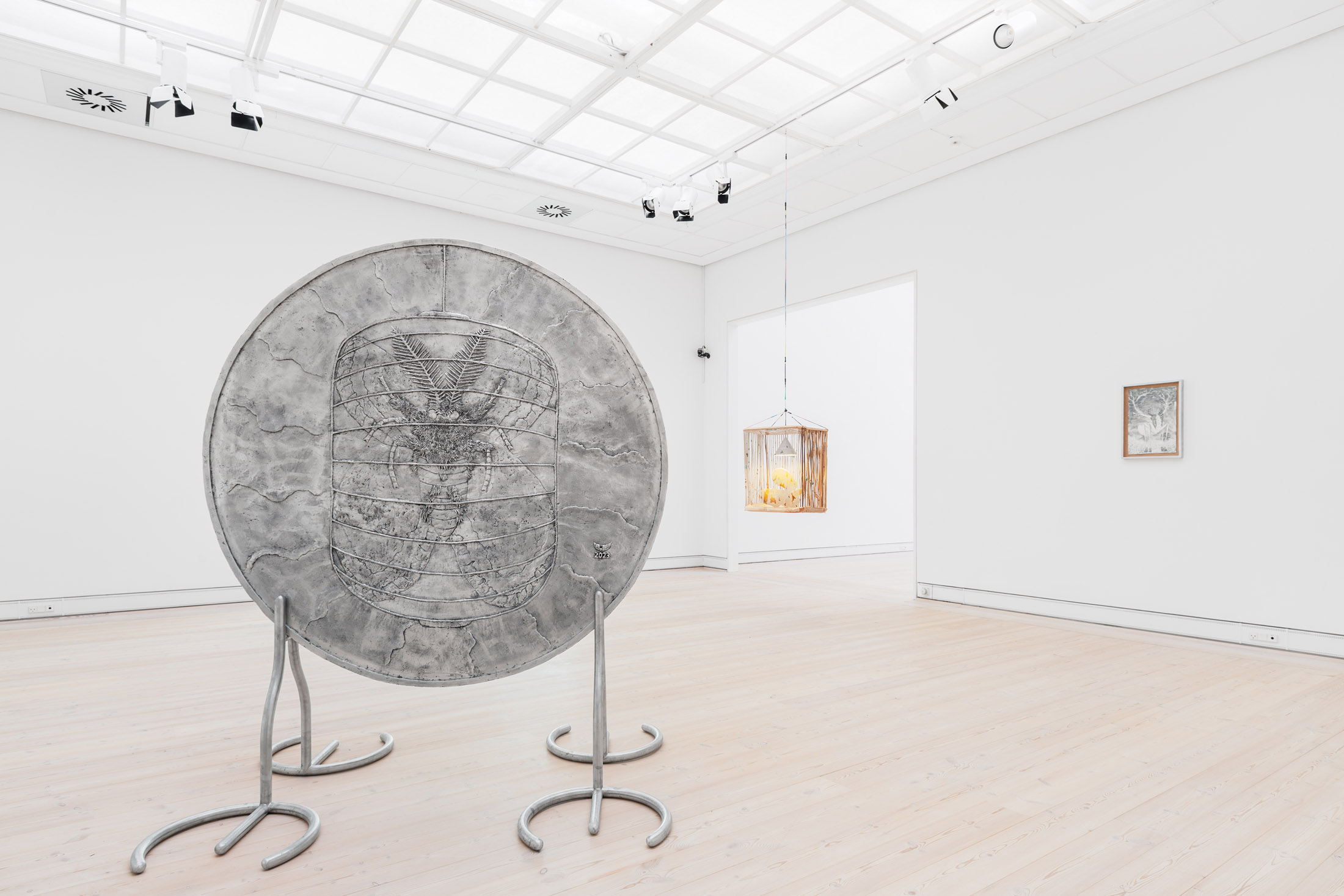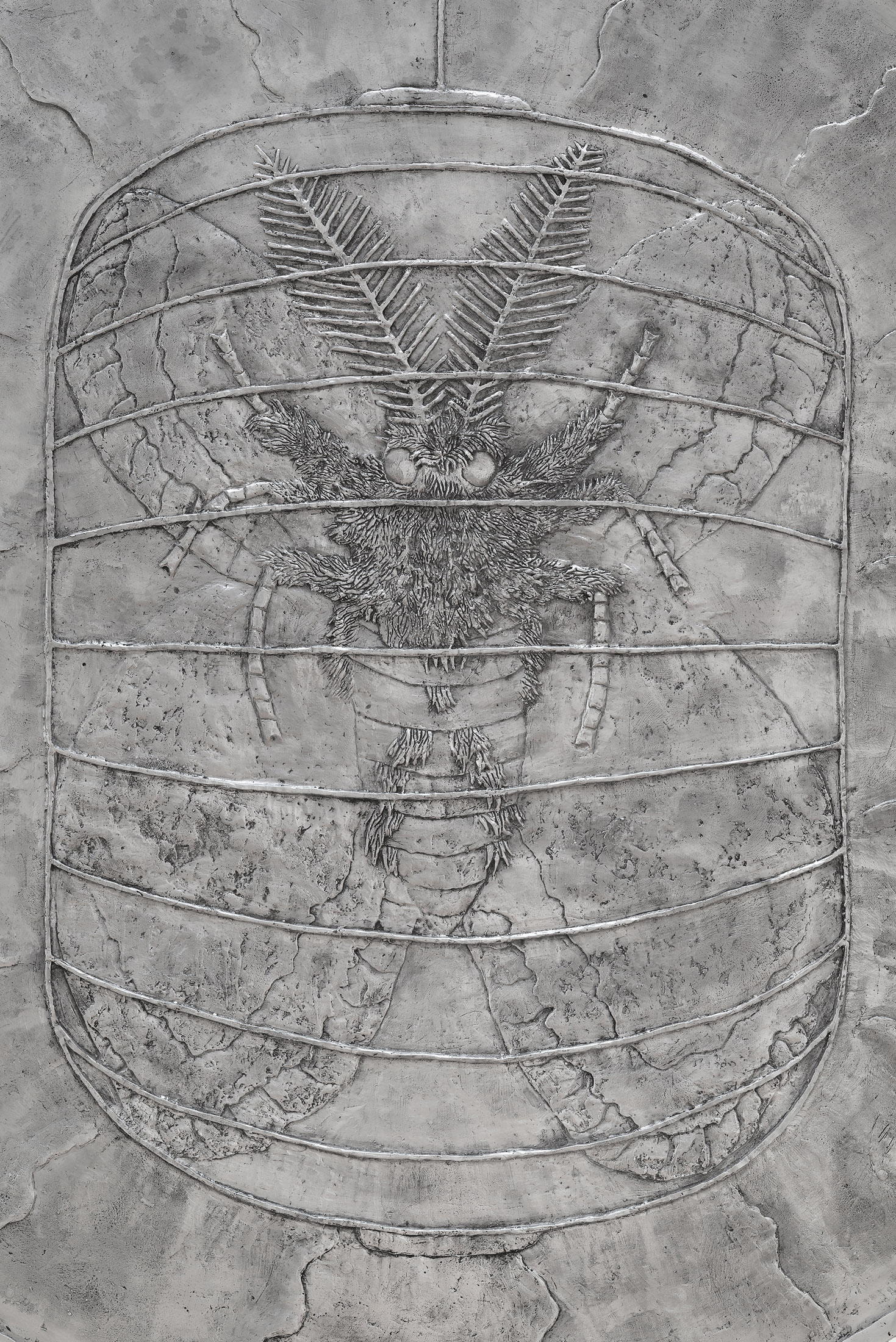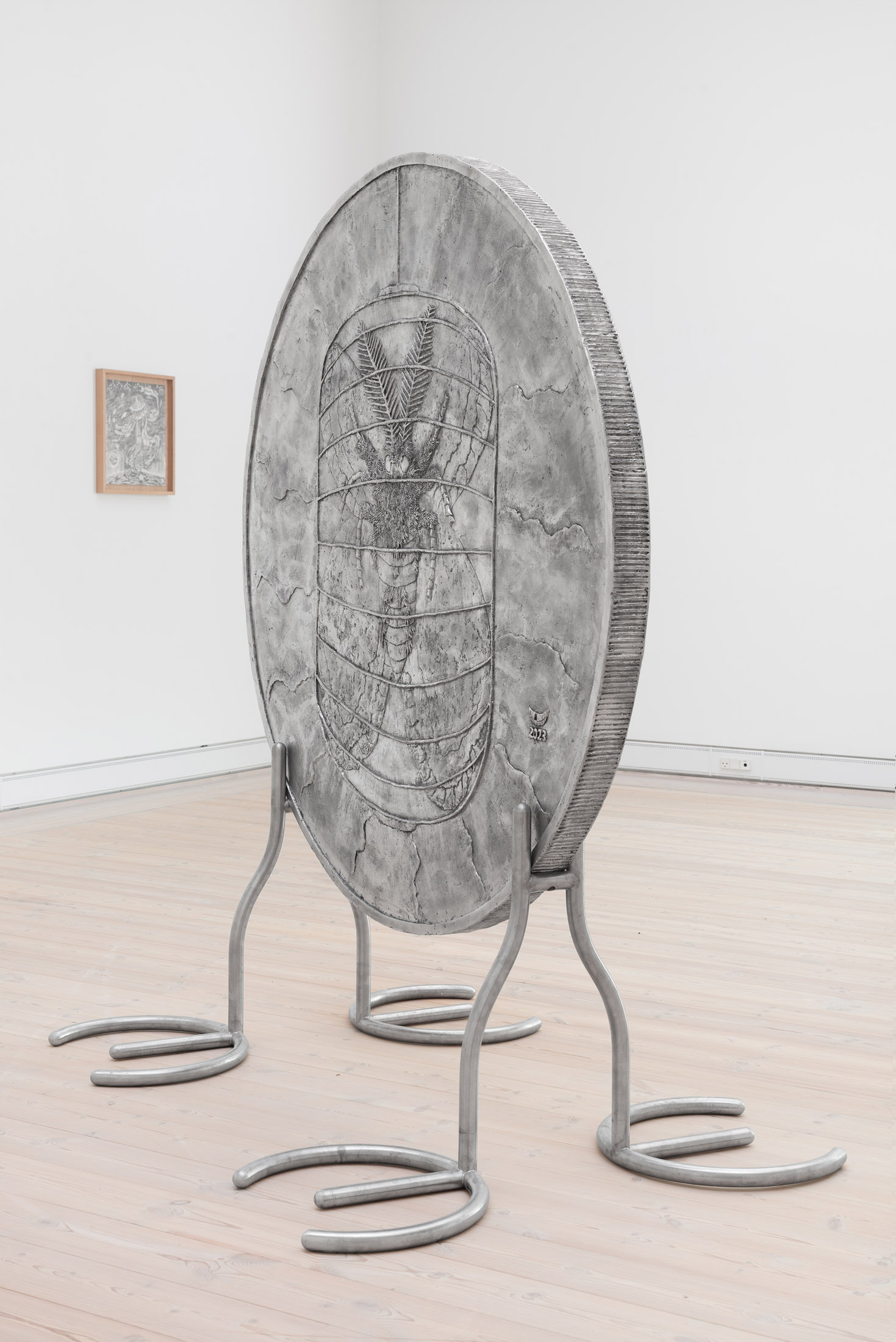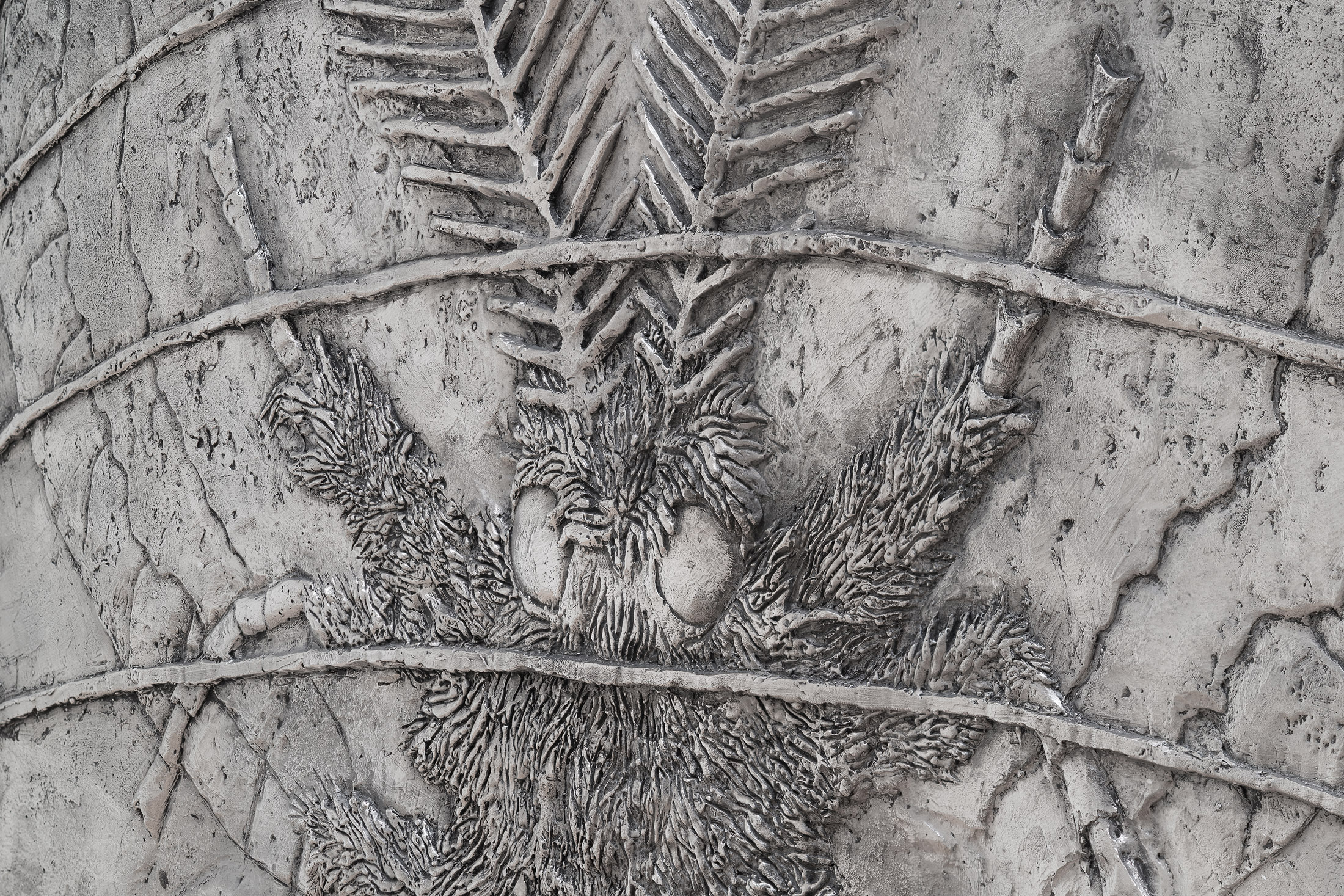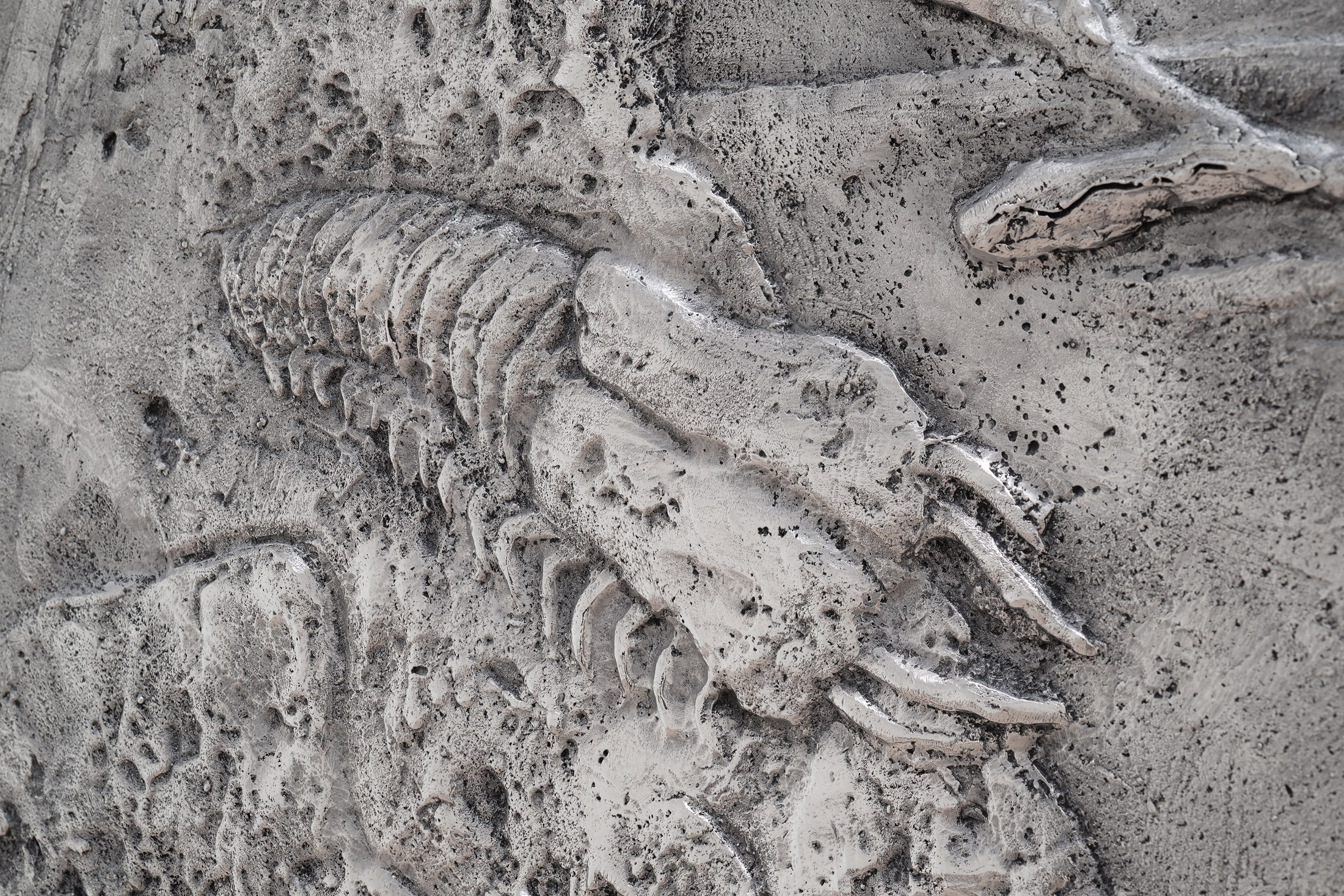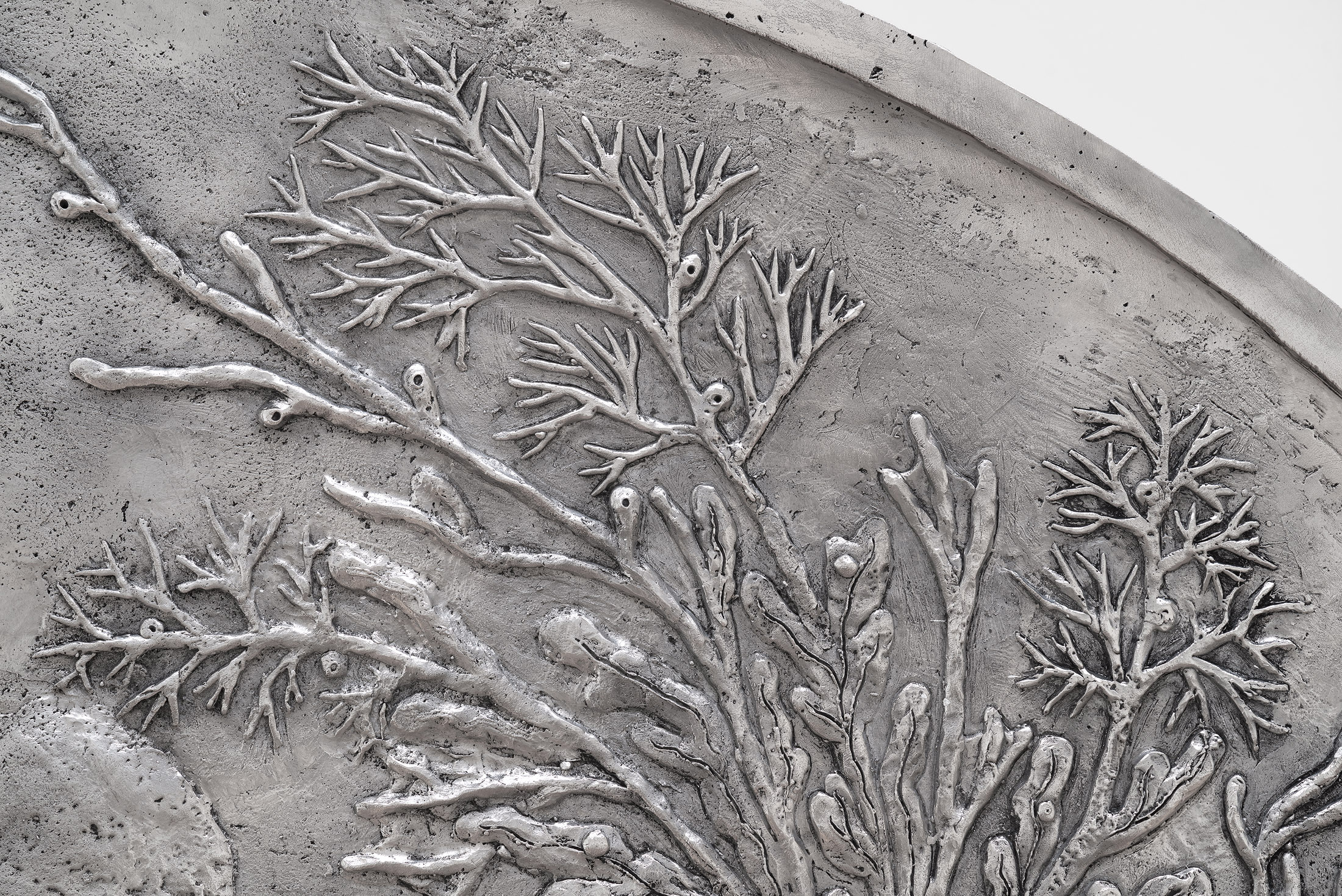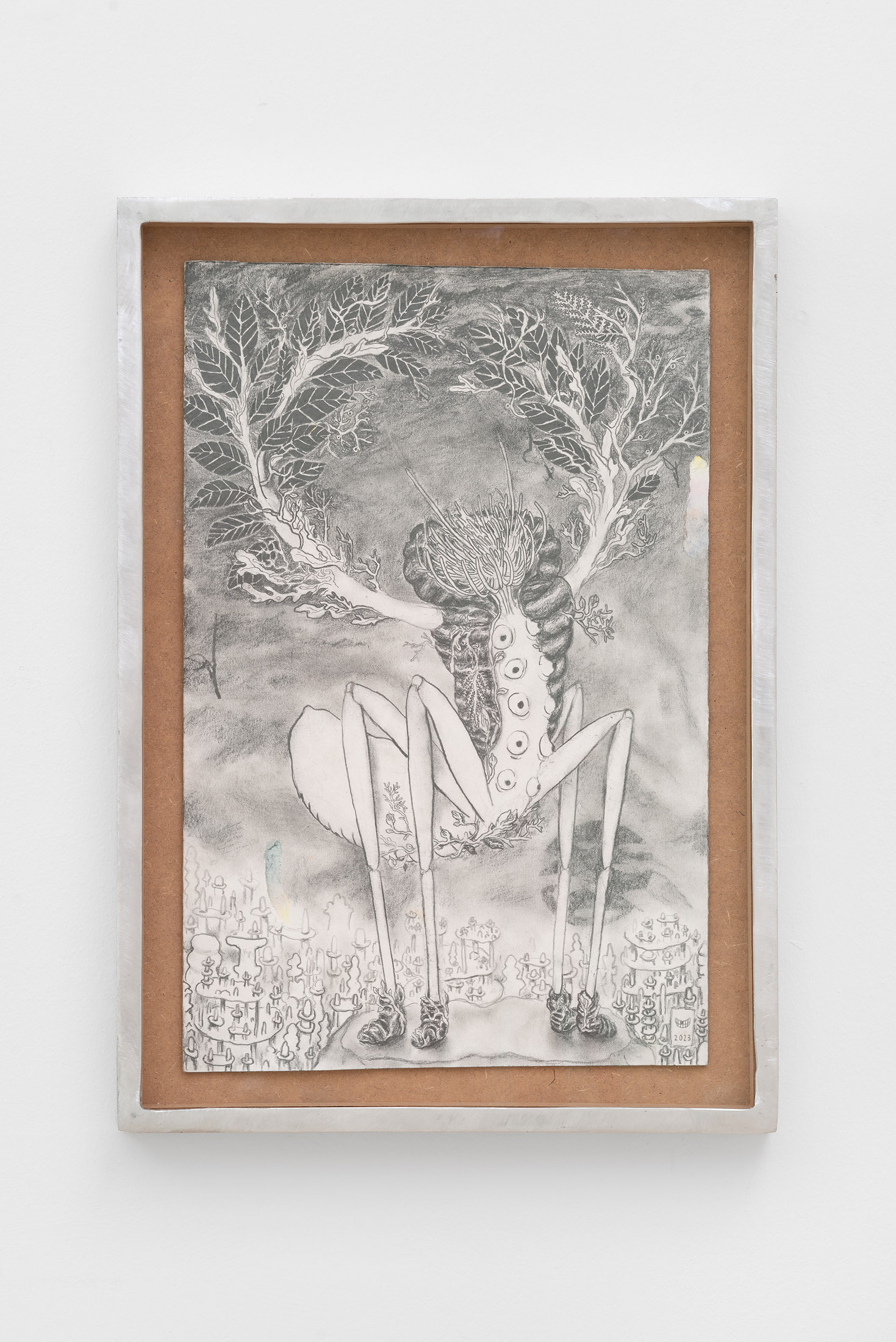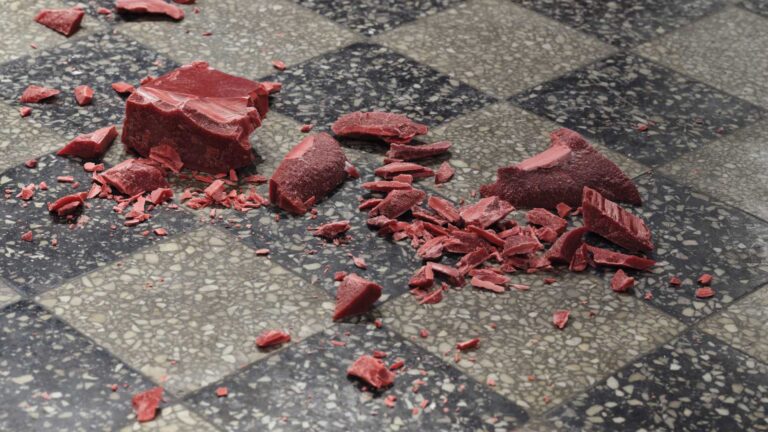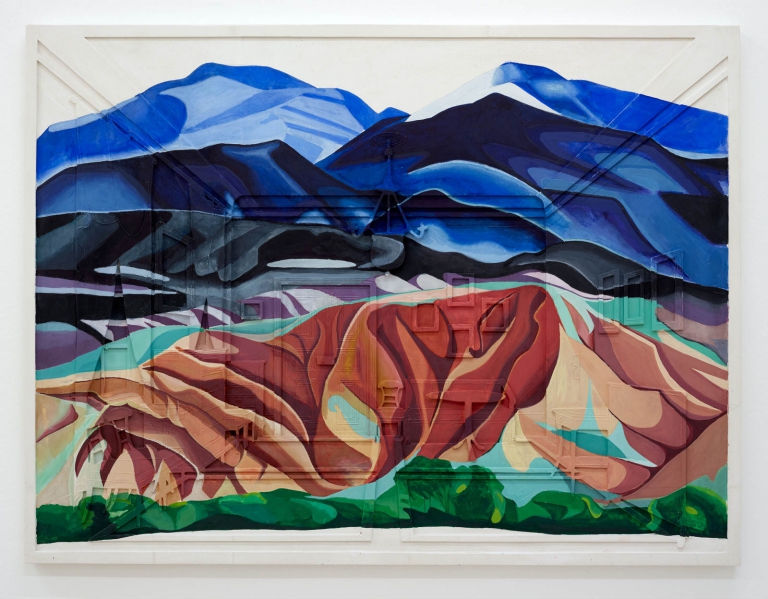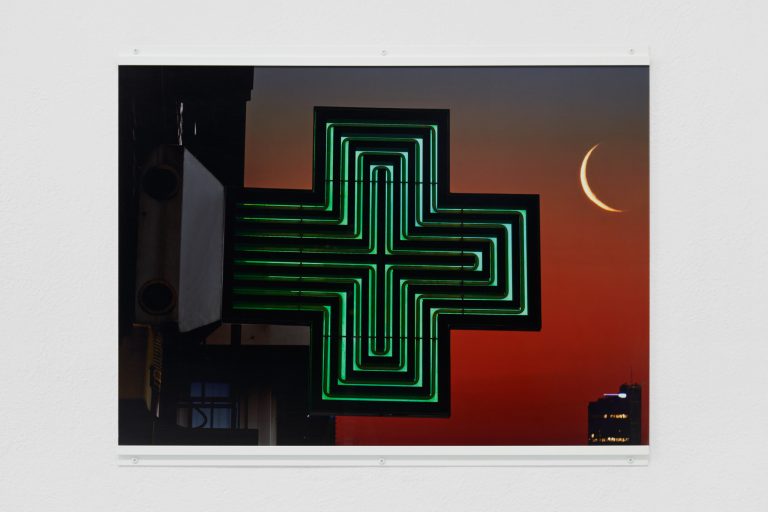Artist: Silas Inoue
Exhibition title: Lower Lifeforms
Venue: Horsens Art Museum, Horsens, Denmark
Date: September 16, 2023 – January 7, 2024
Photography: all images courtesy of the artist and Horsens Art Museum
Horsens Art Museum presents Lower Lifeforms, a solo exhibit of work by the artist Silas Inoue (b.1981). Featuring sculptures, installations and drawings, this is the artist’s first solo show at Horsens Art Museum.
Lower Lifeforms is a tribute to life forms we regard as inferior, and to materials we normally consider impure and worthless. The exhibit features a fanciful underworld of demonic creatures, anthropomorphic insects, magnified aquatic organisms and bio-futuristic cityscapes inhabited by molds. However, even though at first glance they appear to portray non-human entities, to a great extent the works in Lower Lifeforms reflect us as human beings, and the inclinations, both likeable and unlikeable, that characterize our species and the age in which we live.
The exhibit presents both earlier and newly produced sculptures and installations. There are also a number of drawings, which serve as a kind of pictorial network, reflecting recurrent motifs, figures and organisms, and creating cohesion between the different rooms of the exhibit.
Lower Lifeforms starts on the façade of the museum building, on which a colorful neon sign glows. The sign depicts five organic figures. While drawing inspiration from different types of lichen they also resemble letters, which together allude to the word lover. Lichen is a composite organism consisting of a fungus that exists in a symbiotic relationship with a green alga. While algae draw energy from sunlight (photosynthesis), fungi feed on other organ-isms, both living and dead. In other words, lichen is an example of symbiosis between species of radically different natures. The sign can be viewed as a tribute to this kind of double organism, while simultaneously alluding to urban life, advertising, sex shops and carnal bargain hunting.
Fungi represent a recurring field of interest in the work of Silas Inoue. In the first room of the exhibit, we encounter works from the artist’s Infrastructure series, which can be viewed as an analogy to population growth in cities. Inoue has been working on the series since 2015, after a flood in his studio, when several works were attacked by mold. The series features small, sculptural biotopes made of organic and synthetic materials, on which mold was allowed to settle. The fungi spread over the sculptures like individuals in a microcosm; like humans, they are competing for space and resources. The tops are fitted with bronze respiratory systems to supply the fungi with oxygen, at the same time ensuring that spores do not escape into reality.
The room adjacent to the fungal works also features a kind of coexistence. In a grease tray filled with used Mc-Donald’s frying oil sits a seven-meter-long skewer, on which a number of widely different sculptures have been impaled. Depicting courses in a meal, they look like some sort of fusion cuisine, in which East meets West and nature meets culture. Each has its own narrative and materiality. We see: a gingerbread temple, its roofs covered with seaweed and adorned with glaze and kompeitou (colorful Japanese sugar candy); a sugar-glazed jellyfish; a wolf’s head with burs, mud and felt; a melted-microplastic chip sprinkled with salt crystals; an isomalt and plastic pupa; and a bat made of fat with added garlic and flavor enhancers. Together, the ideas, materials and meanings embedded in Skewer form an ongoing exchange between equality and diversity. Both serious and humorous, the work questions people’s understanding of nationality, the survival of the species and the food supply of the future.
The central room of the exhibit is home to an indeterminate creature taking a bath in a huge oak tub. Its body is made up of plastic hoses and tailpipes, both new and used, from cars and motorbikes. A motion sensor activates a fog machine in the creature’s belly, causing the pipes to expel a white haze. When the haze fills the room and settles on the surface of the water, it creates a steamy, spa-like ambience, while also evoking a mysterious kind of air pollution. On the edge of the tub there is a selection of plants that add to the feeling of luxury and wellness, accompanied by little sculptures depicting figures that frequently crop up in Inoue’s works. On the one hand, the creature in the tub can be viewed as the offspring of the world’s fossil industries, equipped with its own self-willed agency, and an implicitly flamboyant self-image, which it nurtures in the tub as if in a process of greenwashing. On the other hand, we might say that the creature is undergoing a kind of purification or rebirth, in which it will manage to get rid of the fossil fuels that created it.
Next to Wash (as this monstrous sculpture is titled), we encounter Silur: an odd, highly detailed creepy-crawly – a bronze millipede rolled up on a banana leaf. The millipede is a prehistoric creature dating back to the geological period known as the Silurian – 443-417 million years ago. The millipede was one of the first creatures to colonize dry land. A variety of millipede species still exists over almost the entire world. Particularly in forests, they play a key role in the composting of leaves and other dead, organic material. The work refers to age-old traditions of looking at time in a non-linear way; but also, to the organic cycles that prevail in any ecosystem.
In the rear exhibition room, the interaction between enlarged and microscopic motifs is just as striking. Placed on a stainless-steel stand is a huge aluminum coin, while from the ceiling hangs a small, fragile, wood-and-bam-boo cage. The cage contains a sugar flower that has opened, as if waiting to be pollinated by insects, who can get to it through the numerous chinks of the cage and the gaps in the delicate mesh that hangs in front of it like a curtain. Like the stamens of real flowers, the sugar the flower is made of will attract pollinating insects. However, unlike normal pollination between flowers and bees, its infertile sugar means that the flower sculpture does not assist any kind of reproduction in nature. Above the flower is a lamp, which not only adds to the sense of claustrophobic confinement and control, but also illuminates the work and attracts insects. The sculpture is all about the progress of life, from both a human and non-human perspective, in which reproduction and symbiosis are inextricably linked to corrosion and dissolution. To an extent, as human observers we are denied access to the flower. Although the sugar attracts us, just as nectar attracts insects, we may only look at it through the narrow, peephole-like chinks of the cage and the gaps in the curtain. We become like voyeurs, peering at the processes involved in sex, reproduction and symbiosis that take place in the open air.
In the coin next to the cage is one of the nocturnal insects that gets attracted to the light. The motif on the back of the coin is of a moth trapped in a lamp, not unlike the one hanging above the flower in the cage. The motif was inspired by the self-destructive tendency of insects such as moths, drawn as they are to human-made, artificial lighting. As yet, there is no scientific explanation as to why moths veer so relentlessly towards the light source that frequently ends up killing them. One theory is that nocturnal insects such as these use the moon and stars for navigation, and that their evolution did not equip them to distinguish between artificial lighting and natural light. Another theory is based on the fact that sexually mature female moths secrete a faint source of light, so the males mistakenly believe that the artificial light stems from females. The main point of the motif is that we cannot really explain why moths do what they do – just as we cannot explain why humans are attracted to living in ways that lead to their demise.
The motif on the front is of a kind of sea goddess posing as if in a commercial, making herself a desirable object for the various organisms that have spotted her or have already sucked and stuck themselves to her. We also notice that the arms of the goddess are turning into algae, rising towards the sky in a growth-like movement. While this symbolizes the force of attraction and symbiosis, it is also an allegory of economic dependency. As a whole, Bond can be viewed as a depiction of how, today, concrete and abstract concepts such as money, desire, growth and entropy have become fused, and how modern humans are subject to this fusion.
In Lower Lifeforms, Silas Inoue (b. 1981) has created a universe in which analytical thought interacts with more intuitive perceptions of the world. Together, poetry and science form the basis for new ways of shedding light on topics such as consciousness, evolution, ecology, economics, consumption and globalization.
The hallmarks of Silas Inoue’s work are contrast and ambiguity: not only when it comes to scale, but also in terms of his choice of materials and themes. In oversized sculptures, detailed drawings and living microcosms, tradition merges with utter lack of convention. Classic materials such as paper, wood and bronze are juxtaposed with plastic, sugar, frying oil, molds and other living organisms in a multifaceted universe, reflecting an approach to nature and technology that is charged with humor and immediacy. The artist himself describes his style as ‘quasi-Asian’: a reference to his half-Eastern, half-Western origins.
Inoue’s works have been exhibited both in Denmark and abroad, at venues that include Ulterior Gallery (New York City), Sonje Art Center (Seoul), CAPC (Bordeaux), Bornholm Art Museum, Kunsthal Aarhus, Arken, Gl. Holtegaard, and Sorø Art Museum.
The exhibition Lower Lifeforms at Horsens Art Museum has received generous funding from: Knud Højgaards Fond, 15. Juni Fonden, Augustinus Fonden, Statens Kunstfond, Statens Værk- steder, Grosserer L. F. Foghts Fond, Beckett Fonden, Familien Hede Nielsens Fond, Overretssag- fører L. Zeutens Mindelegat and Insero Hors-ens.
Silas Inoue, Lower Lifeforms, 2023, exhibition view, Horsens Art Museum
Silas Inoue, Lichen, 2023, neon, 190 × 305 cm
Silas Inoue, Lichen, 2023, neon, 190 × 305 cm
Silas Inoue, Lichen, 2023, neon, 190 × 305 cm
Silas Inoue, Forecaster, 2023, pencil, watercolor, soil, paper, smoked oak wood, museum glass, 43 x 48 cm
Silas Inoue, Lower Lifeforms, 2023, exhibition view, Horsens Art Museum
Silas Inoue, Infrastructure, 2020, clear acrylic, wood, plastic, radiant acrylic, mold, concrete, bronze, filter, 131 x 45 x 30 cm
Silas Inoue, Infrastructure, 2020, clear acrylic, wood, plastic, radiant acrylic, mold, concrete, bronze, filter, 131 x 45 x 30 cm
Silas Inoue, Infrastructure, 2020, clear acrylic, wood, plastic, radiant acrylic, silicone, isomalt, mold, concrete, bronze, filter, 117 x 60 x 40 cm
Silas Inoue, Infrastructure, 2020, clear acrylic, wood, plastic, radiant acrylic, silicone, isomalt, mold, concrete, bronze, filter, 117 x 60 x 40 cm
Silas Inoue, Infrastructure, 2020, clear acrylic, wood, plastic, radiant acrylic, silicone, isomalt, mold, concrete, bronze, filter, 117 x 60 x 40 cm
Silas Inoue, Infrastructure, 2023, clear acrylic, wood, plastic, radiant acrylic, mold, concrete, bronze, filter, 95 × 114 × 44 cm
Silas Inoue, Infrastructure, 2023, clear acrylic, wood, plastic, radiant acrylic, mold, concrete, bronze, filter, 95 × 114 × 44 cm
Silas Inoue, Infrastructure, 2023, clear acrylic, wood, plastic, radiant acrylic, mold, concrete, bronze, filter, 95 × 114 × 44 cm
Silas Inoue, Infrastructure, 2018, clear acrylic, wood, palm leaves, plant seeds, mold, concrete, bronze, filter, 130×50×40 cm
Silas Inoue, Infrastructure, 2018, clear acrylic, wood, palm leaves, plant seeds, mold, concrete, bronze, filter, 130×50×40 cm
Silas Inoue, Infrastructure, 2020, clear acrylic, wood, plastic, radiant acrylic, mold, concrete, bronze, filter, 131 x 45 x 30 cm
Silas Inoue, Infrastructure, 2020, clear acrylic, wood, plastic, radiant acrylic, mold, concrete, bronze, filter, 131 x 45 x 30 cm
Silas Inoue, Night Bloom, 2023, pencil, watercolor, soil, paper, ash wood, anti-reflective acrylic,77 x 84,5 cm
Silas Inoue, Lower Lifeforms, 2023, exhibition view, Horsens Art Museum
Silas Inoue, Skewer, 2022, steel, MDF, oak wood, foam, used frying oil (Mc-Donald’s), burnt acrylic, sugar, silicone, felt, mud, burrs, rice, isomalt, gingerbread, roastedseaweed, icing, Kompeitou, salt crystals, vegetarian garlic fat, flavor enhancers, 700 × 200 × 230 cm
Silas Inoue, Skewer, 2022, steel, MDF, oak wood, foam, used frying oil (Mc-Donald’s), burnt acrylic, sugar, silicone, felt, mud, burrs, rice, isomalt, gingerbread, roastedseaweed, icing, Kompeitou, salt crystals, vegetarian garlic fat, flavor enhancers, 700 × 200 × 230 cm
Silas Inoue, Skewer, 2022, steel, MDF, oak wood, foam, used frying oil (Mc-Donald’s), burnt acrylic, sugar, silicone, felt, mud, burrs, rice, isomalt, gingerbread, roastedseaweed, icing, Kompeitou, salt crystals, vegetarian garlic fat, flavor enhancers, 700 × 200 × 230 cm
Silas Inoue, Skewer, 2022, steel, MDF, oak wood, foam, used frying oil (Mc-Donald’s), burnt acrylic, sugar, silicone, felt, mud, burrs, rice, isomalt, gingerbread, roastedseaweed, icing, Kompeitou, salt crystals, vegetarian garlic fat, flavor enhancers, 700 × 200 × 230 cm
Silas Inoue, Skewer, 2022, steel, MDF, oak wood, foam, used frying oil (Mc-Donald’s), burnt acrylic, sugar, silicone, felt, mud, burrs, rice, isomalt, gingerbread, roastedseaweed, icing, Kompeitou, salt crystals, vegetarian garlic fat, flavor enhancers, 700 × 200 × 230 cm
Silas Inoue, Skewer, 2022, steel, MDF, oak wood, foam, used frying oil (Mc-Donald’s), burnt acrylic, sugar, silicone, felt, mud, burrs, rice, isomalt, gingerbread, roastedseaweed, icing, Kompeitou, salt crystals, vegetarian garlic fat, flavor enhancers, 700 × 200 × 230 cm
Silas Inoue, Skewer, 2022, steel, MDF, oak wood, foam, used frying oil (Mc-Donald’s), burnt acrylic, sugar, silicone, felt, mud, burrs, rice, isomalt, gingerbread, roastedseaweed, icing, Kompeitou, salt crystals, vegetarian garlic fat, flavor enhancers, 700 × 200 × 230 cm
Silas Inoue, Deep Fry, 2023, pencil, watercolor, soil, paper, stainless steel, anti-reflective acrylic, 126 x 116 cm
Silas Inoue, Deep Fry, 2023, pencil, watercolor, soil, paper, stainless steel, anti-reflective acrylic, 126 x 116 cm
Silas Inoue, Lower Lifeforms, 2023, exhibition view, Horsens Art Museum
Silas Inoue, Lower Lifeforms, 2023, exhibition view, Horsens Art Museum
Silas Inoue, Wash, 2023, new and used car and motorcycle parts, e-waste, wires, plastic pipes, silicone, oak wood, smoked oak wood, bronze, filter, concrete, glass, acrylic, sugar, oil, mold, plants, water, mist- maker, 140 × 760 × 560 cm (variable measures)
Silas Inoue, Wash, 2023, new and used car and motorcycle parts, e-waste, wires, plastic pipes, silicone, oak wood, smoked oak wood, bronze, filter, concrete, glass, acrylic, sugar, oil, mold, plants, water, mist- maker, 140 × 760 × 560 cm (variable measures)
Silas Inoue, Wash, 2023, new and used car and motorcycle parts, e-waste, wires, plastic pipes, silicone, oak wood, smoked oak wood, bronze, filter, concrete, glass, acrylic, sugar, oil, mold, plants, water, mist- maker, 140 × 760 × 560 cm (variable measures)
Silas Inoue, Wash, 2023, new and used car and motorcycle parts, e-waste, wires, plastic pipes, silicone, oak wood, smoked oak wood, bronze, filter, concrete, glass, acrylic, sugar, oil, mold, plants, water, mist- maker, 140 × 760 × 560 cm (variable measures)
Silas Inoue, Wash, 2023, new and used car and motorcycle parts, e-waste, wires, plastic pipes, silicone, oak wood, smoked oak wood, bronze, filter, concrete, glass, acrylic, sugar, oil, mold, plants, water, mist- maker, 140 × 760 × 560 cm (variable measures)
Silas Inoue, Wash, 2023, new and used car and motorcycle parts, e-waste, wires, plastic pipes, silicone, oak wood, smoked oak wood, bronze, filter, concrete, glass, acrylic, sugar, oil, mold, plants, water, mist- maker, 140 × 760 × 560 cm (variable measures)
Silas Inoue, Lower Lifeforms, 2023, exhibition view, Horsens Art Museum
Silas Inoue, Wash, 2023, new and used car and motorcycle parts, e-waste, wires, plastic pipes, silicone, oak wood, smoked oak wood, bronze, filter, concrete, glass, acrylic, sugar, oil, mold, plants, water, mist- maker, 140 × 760 × 560 cm (variable measures)
Silas Inoue, Mushi, 2023, pencil, watercolor, soil, paper, oak wood, museum glass, 138 x 104 cm
Silas Inoue, Silur, 2019, bronze, banana leaves, 6 x 70 x 35 cm
Silas Inoue, Silur, 2019, bronze, banana leaves, 6 x 70 x 35 cm
Silas Inoue, Crude, 2023, pencil, watercolor, soil, paper, oak wood, museum glass, 46 x 51 cm
Silas Inoue, Lower Lifeforms, 2023, exhibition view, Horsens Art Museum
Silas Inoue, Re;prʘductiʘn, 2023, Oak wood, Douglas fir, bamboo, acrylic, plastic, sugar, lamp, bulb, wires, 64 x 57 x 47 cm
Silas Inoue, Re;prʘductiʘn, 2023, Oak wood, Douglas fir, bamboo, acrylic, plastic, sugar, lamp, bulb, wires, 64 x 57 x 47 cm
Silas Inoue, Re;prʘductiʘn, 2023, Oak wood, Douglas fir, bamboo, acrylic, plastic, sugar, lamp, bulb, wires, 64 x 57 x 47 cm
Silas Inoue, Lower Lifeforms, 2023, exhibition view, Horsens Art Museum
Silas Inoue, Bond, 2023, aluminum, stainless steel, 189 × 153 × 107 cm
Silas Inoue, Bond, 2023, aluminum, stainless steel, 189 × 153 × 107 cm
Silas Inoue, Bond, 2023, aluminum, stainless steel, 189 × 153 × 107 cm
Silas Inoue, Bond, 2023, aluminum, stainless steel, 189 × 153 × 107 cm
Silas Inoue, Bond, 2023, aluminum, stainless steel, 189 × 153 × 107 cm
Silas Inoue, Bond, 2023, aluminum, stainless steel, 189 × 153 × 107 cm
Silas Inoue, Bond, 2023, aluminum, stainless steel, 189 × 153 × 107 cm
Silas Inoue, Bond, 2023, aluminum, stainless steel, 189 × 153 × 107 cm
Silas Inoue, Bond, 2023, aluminum, stainless steel, 189 × 153 × 107 cm
Silas Inoue, Lower Lifeforms, 2023, exhibition view, Horsens Art Museum
Silas Inoue, Nymph, 2023, pencil, watercolor, soil, paper, aluminum, anti-reflective acrylic. 38 x 54 cm



